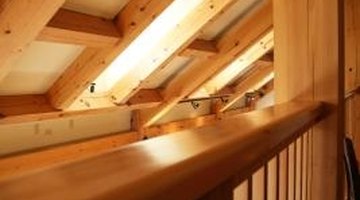How to Insect Proof Wood Without Chemicals
Although it is important to treat wood to protect it from insects and the damage they cause, many wood preservative products have noxious chemical ingredients known to be carcinogenic, endocrine disruptors or neurotoxins. Such products have been linked with numerous health conditions. Fortunately, there are natural alternatives that contain harmless products that are good for people and for the environment.
Oils and Oil-Based Products

-
Pick the product you prefer to use. Raw linseed oil is natural oil from flax seed. It dries slowly and can take weeks to sink into the wood. Heat treated linseed oil will dry more quickly. Linseed oil is economical. "Boiled" linseed oil has chemicals added to it that evaporate and help the oil dry more quickly; this type of linseed oil is toxic. Most linseed oil has toxic chemicals added as preservatives, so be sure it is pure oil and additive free. Tung oil is a long-used natural oil from China. It penetrates wood and then hardens. Oil-bound distemper is free of harmful ingredients and is an economical yet durable paint. It comes as a paste, and is mixed with water. It can also be mixed with natural colors. It is not washable so dirt and stains must be painted over.
-
Purchase the product at home maintenance retailers or specialty stores.
-
Apply oils with a paint brush or cloth. Oil-bound distemper should be painted onto the wood with a brush, first with horizontal strokes, followed by vertical strokes.
Water-Based Products
-
Pick the method you want to use. Lime wash is a simple "paint" made from lime putty and water; it is similar to whitewash. Natural metal oxide minerals can be added for color. It is breathable, and the alkalinity deters wood-boring beetles and insects; it also helps sterilize walls. It is inexpensive, free of chemical solvents, and if done properly is stable and won't easily rub off onto clothing. Soft distemper is a natural paint that is water based and typically a mix of pulverized chalk and natural glue from animal parts. Popular during the industrial revolution, it can be colored with natural metal oxide minerals. It has been used on paper, wood, brick and stone, but is best for indoor use. Boric acid and related salts and oxides, or borates, are effective at deterring insects such as termites. They have a low toxicity level for humans; boric acid is used as an eyewash for example. They can only be used indoors where the borates will not leach back out of the wood.
-
Purchase the product at home maintenance retailers or specialty stores.
-
Prepare and mix per the instructions. Apply with a brush or cloth. Borate solution can be sprayed or painted onto wood.
References
Resources
Tips
- Some wood naturally resists insects and decay. The heartwood (but not the sapwood) of certain types of trees will naturally resist insects. These include some cedar, coast redwood, many cypress woods, and ironbark heartwood from Australia.
Warnings
- Wear masks and eye protection, especially when working with lime products.
Photo Credits
- Jupiterimages/Photos.com/Getty Images
More Articles


